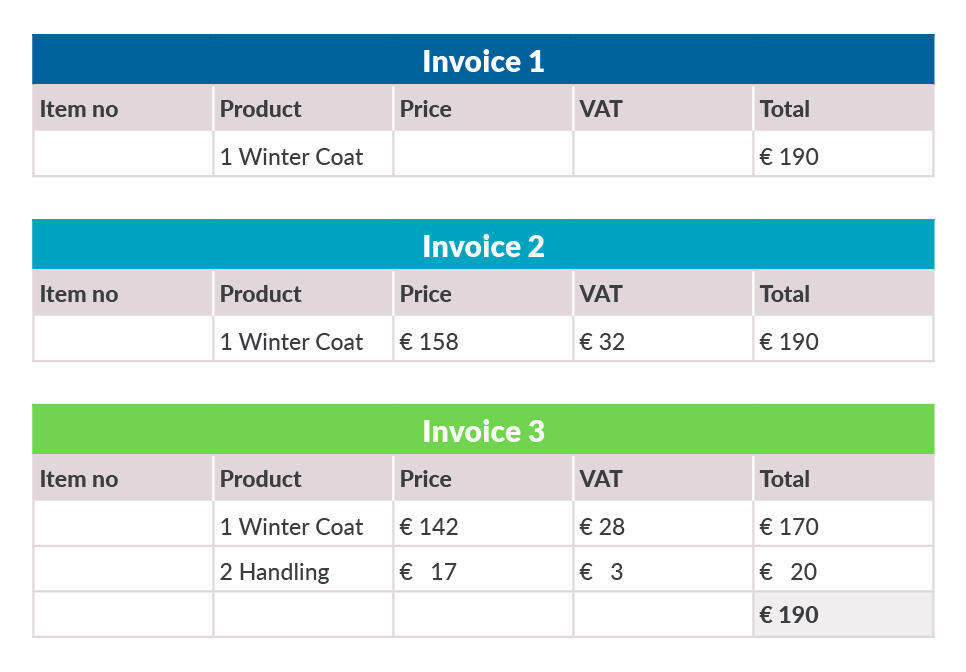The new EU VAT rules for e-commerce that take effect on 1 July 2021 reference the phrase "consignments of an intrinsic value" a few times. The primary references regard:
- Marketplaces: Under the new rules, marketplaces are deemed as the supplier for VAT for distance sales of goods from non-EU countries (third country) in consignments of an intrinsic value not exceeding EUR 150;
- Import Scheme: The import scheme applies only for goods dispatched from a third country in a consignment of an intrinsic value not exceeding EUR 150; and
- Postal Operators and Express Carriers: The special arrangement for postal operators and express carriers also refers to these consignments. All of these follow the threshold for the EU customs duty exemption.
But what is actually meant with the terms "consignment" and "intrinsic value?"
A single consignment is:
- Goods packed together, and
- Dispatched simultaneously, by the
- Same consignor (supplier, underlying supplier, or marketplace), to the
- Same consignee (customer in the EU), and covered by the
- Same transport contract
Consequently, goods dispatched by the same consignor to the same consignee that were ordered and shipped separately, even if arriving on the same day but as separate parcels, would be separate consignments. However, if goods are ordered separately but dispatched together, this would still be a single consignment. If there is a suspicion that the consignment was split on purpose to avoid customs duties, it should still be considered a single consignment. This could, for example, be the case if a pair of shoes are dispatched as separate items.
Marketplaces or other electronic interfaces are required to make assumptions when multiple products are ordered, but they do not have the information at the time of payment if the underlying supplier will dispatch the products in one or multiple consignments. So, if the same customer orders multiple products simultaneously and from the same vendor, the marketplace would assume it will be one single consignment.
The other element is the intrinsic value for which the customs legislation has introduced an EU-wide legally binding definition:
"The price of the goods themselves when sold for export to the EU, excluding transport and insurance costs, unless they are included in the price and not separately indicated on the invoice, and any other taxes and charges."
So, this is the customer's net price at the time of the supply (i.e. when the payment was accepted), as shown on the commercial invoice accompanying the goods. To avoid discussions on the intrinsic value of the products, the VAT, transport fees, insurance, export taxes, etc., should be specified on the invoice. When invoicing for a sale in a currency other than the euro, it is advised to indicate the price in EUR when the payment is accepted to prevent issues from exchange rate fluctuations.
In this simplified example, a customer in the EU orders a winter coat through a marketplace from a Canadian vendor.
Invoice 1 doesn’t specify any details, so determining the intrinsic value is a challenge. Let’s look at possible scenario that highlights the difficulties: Prices to consumers in the EU are including VAT, so the applicable VAT rate impacts the intrinsic value. In Hungary, for example, the VAT rate is 27%, so the intrinsic value of the winter coat on invoice 1 would be EUR 149,60. But what if the consignee is located in Luxembourg, where the VAT rate is 17%? The intrinsic value would be EUR 165,22. Although this may seem like a subtle difference, the lack of information makes it challenging for either consignee to prove the intrinsic value of the coat. Therefore, tax authorities must work based on assumptions to determine who is responsible for collecting the tax.
On invoice 2, the VAT is specified, and the intrinsic value is EUR 158. As a result, the marketplace is not the deemed supplier for VAT and the Import OSS (I-OSS) cannot be used.
On invoice 3, both the VAT and the handling costs are specified. As a result, the intrinsic value is below the EUR 150 threshold. The marketplace will be the deemed seller for this supply, and I-OSS can be used to account for the VAT.
Both the concepts of consignment and intrinsic value impact who is liable for VAT and how this should be reported. As a result, these invoice details need to be carefully considered when selling third country products online to EU customers at or near the EUR 150 price point.



